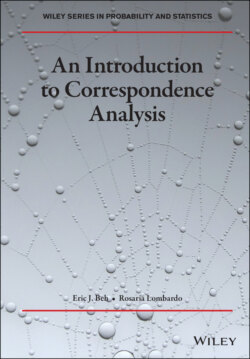An Introduction to Correspondence Analysis

Реклама. ООО «ЛитРес», ИНН: 7719571260.
Оглавление
Eric J. Beh. An Introduction to Correspondence Analysis
Table of Contents
List of Tables
List of Illustrations
Guide
Pages
Wiley Series in Probability and Statistics
An Introduction to Correspondence Analysis
Preface
1 Introduction. 1.1 Data Visualisation
1.2 Correspondence Analysis in a “Nutshell”
1.3 Data Sets
1.3.1 Traditional European Food Data
1.3.2 Temperature Data
1.3.3 Shoplifting Data
1.3.4 Alligator Data
1.4 Symmetrical Versus Asymmetrical Association
1.5 Notation
1.5.1 The Two-way Contingency Table
1.5.2 The Three-way Contingency Table
1.6 Formal Test of Symmetrical Association
1.6.1 Test of Independence for Two-way Contingency Tables
1.6.2 The Chi-squared Statistic for a Two-way Table
1.6.3 Analysis of the Traditional European Food Data
1.6.4 The Chi-squared Statistic for a Three-way Table
1.6.5 Analysis of the Alligator Data
1.7 Formal Test of Asymmetrical Association. 1.7.1 Test of Predictability for Two-way Contingency Tables
1.7.2 The Goodman–Kruskal tau Index
1.7.3 Analysis of the Traditional European Food Data
1.7.4 Test of Predictability for Three-way Contingency Tables
1.7.5 Marcotorchino’s Index
1.7.6 Analysis of the Alligator Data
1.7.7 The Gray–Williams Index and Delta Index
1.8 Correspondence Analysis and R
1.9 Overview of the Book
2 Simple Correspondence Analysis. 2.1 Introduction
2.2 Reducing Multi-dimensional Space. 2.2.1 Profiles Cloud of Points
2.2.2 Profiles for the Traditional European Food Data
2.2.3 Weighted Centred Profiles
2.3 Measuring Symmetric Association
2.3.1 The Pearson Ratio
2.3.2 Analysis of the Traditional European Food Data
2.4 Decomposing the Pearson Residual for Nominal Variables
2.4.1 The Generalised SVD of
2.4.2 SVD of the Pearson Ratio’s
2.4.3 GSVD and the Traditional European Food Data
2.5 Constructing a Low-Dimensional Display
2.5.1 Standard Coordinates
2.5.2 Principal Coordinates
2.6 Practicalities of the Low-Dimensional Plot. 2.6.1 The Two-Dimensional Correspondence Plot
2.6.2 What is NOT Being Shown in a Two-Dimensional Correspondence Plot?
2.6.3 The Three-Dimensional Correspondence Plot
2.7 The Biplot Display. 2.7.1 Definition
2.7.2 Isometric Biplots of the Traditional European Food Data
2.7.3 What is NOT Being Shown in a Two-Dimensional Biplot?
2.8 The Case for No Visual Display
2.9 Detecting Statistically Significant Points. 2.9.1 Confidence Circles and Ellipses
2.9.2 Confidence Ellipses for the Traditional European Food Data
2.10 Approximate p-values. 2.10.1 The Hypothesis Test and its p-value
2.10.2 P-values and the Traditional European Food Data
2.11 Final Comments
3 Non-Symmetrical Correspondence Analysis. 3.1 Introduction
3.2 Quantifying Asymmetric Association. 3.2.1 The Goodman–Kruskal tau Index
3.2.2 The Index and the Traditional European Food Data
3.2.3 Weighted Centred Column Profile
3.2.4 Profiles of the Traditional European Food Data
3.3 Decomposing for Nominal Variables. 3.3.1 The Generalised SVD of
3.3.2 GSVD and the Traditional Food Data
3.4 Constructing a Low-Dimensional Display
3.4.1 Standard Coordinates
3.4.2 Principal Coordinates
3.5 Practicalities of the Low-Dimensional Plot. 3.5.1 The Two-Dimensional Correspondence Plot
3.5.2 The Three-Dimensional Correspondence Plot
3.6 The Biplot Display. 3.6.1 Definition
3.6.2 The Column Isometric Biplot for the Traditional Food Data
3.6.3 The Three-Dimensional Biplot
3.7 Detecting Statistically Significant Points. 3.7.1 Confidence Circles and Ellipses
3.7.2 Confidence Ellipses for the Traditional Food Data
3.8 Final Comments
4 Simple Ordinal Correspondence Analysis
4.1 Introduction
4.2 A Simple Correspondence Analysis of the Temperature Data
4.3 On the Mean and Variation of Profiles with Ordered Categories. 4.3.1 Profiles of the Temperature Data
4.3.2 Defining Scores
4.3.3 On the Mean of the Profiles
4.3.4 On the Variation of the Profiles
4.3.5 Mean and Variation of Profiles for the Temperature Data
4.4 Decomposing the Pearson Residual for Ordinal Variables
4.4.1 The Bivariate Moment Decomposition of
4.4.2 BMD and the Temperature Data
4.5 Constructing a Low-Dimensional Display. 4.5.1 Standard Coordinates
4.5.2 Principal Coordinates
4.5.3 Practicalities of the Ordered Principal Coordinates
4.6 The Biplot Display. 4.6.1 Definition
4.6.2 Ordered Column Isometric Biplot
4.6.3 Ordered Row Isometric Biplot
4.6.4 Ordered Isometric Biplots for the Temperature Data
4.7 Final Comments
5 Ordered Non-symmetrical Correspondence Analysis. 5.1 Introduction
5.2 The Goodman–Kruskal tau Index Revisited
5.3 Decomposing for Ordinal and Nominal Variables. 5.3.1 The Hybrid Decomposition of
5.3.2 Hybrid Decomposition and the Shoplifting Data
5.4 Constructing a Low-Dimensional Display. 5.4.1 Standard Coordinates
5.4.2 Principal Coordinates
5.5 The Biplot. 5.5.1 An Overview
5.5.2 Column Isometric Biplot
5.5.3 Column Isometric Biplot of the Shoplifting Data
5.5.4 Row Isometric Biplot
5.5.5 Row Isometric Biplot of the Shoplifting Data
5.5.6 Distance Measures and the Row Isometric Biplots
5.6 Some Final Words
6 Multiple Correspondence Analysis. 6.1 Introduction
6.2 Crisp Coding and the Indicator Matrix. 6.2.1 Crisp Coding
6.2.2 The Indicator Matrix
6.2.3 Crisp Coding and the Alligator Data
6.2.4 Application of Multiple Correspondence Analysis using the Indicator Matrix
6.3 The Burt Matrix
6.4 Stacking. 6.4.1 A Definition
6.4.2 Stacking and the Alligator Data – Lake(Size)Food
6.4.3 Stacking and the Alligator Data – Food(Size)Lake
6.5 Final Comments
7 Multi-way Correspondence Analysis. 7.1 An Introduction
7.2 Pearson’s Residual and the Partition of
7.2.1 The Pearson Residual
7.2.2 The Partition of
7.2.3 Partition of for the Alligator Data
7.3 Symmetric Multi-way Correspondence Analysis
7.3.1 Tucker3 Decomposition of
7.3.2 T3D and the Analysis of Two Variables
7.3.3 On the Choice of the Number of Components
7.3.4 Tucker3 Decomposition of and the Alligator Data
7.4 Constructing a Low-Dimensional Display. 7.4.1 Principal Coordinates
7.4.2 The Interactive Biplot. Two Types of Interactive Biplot
Column–Tube Interactive Biplot
Row Interactive Biplot
7.4.3 Column-Tube Interactive Biplot for the Alligator Data
7.4.4 Row Interactive Biplot for the Alligator Data
7.5 The Marcotorchino Residual and the Partition of. 7.5.1 The Marcotrochino Residual
7.5.2 The Partition of
7.5.3 Partition of for the Alligator Data
7.6 Non-symmetrical Multi-way Correspondence Analysis. 7.6.1 Tucker3 Decomposition of
7.6.2 Tucker3 Decomposition of and the Alligator Data
7.7 Constructing a Low-Dimensional Display. 7.7.1 On the Choice of Coordinates
7.7.2 Column–Tube Interactive Biplot for the Alligator Data
7.8 Final Comments
References
Author Index
Subject Index
WILEY END USER LICENSE AGREEMENT
Отрывок из книги
Established by Walter A. Shewhart and Samuel S. Wilks
Editors: David J. Balding, Noel A. C. Cressie, Garrett M. Fitzmaurice, Geof H. Givens, Harvey Goldstein, Geert Molenberghs, David W. Scott, Adrian F. M. Smith, Ruey S. Tsay
.....
John Clifford Gower (1930–2019)
May your legacy live on
.....